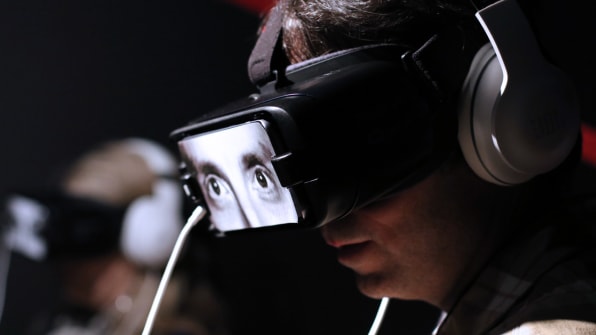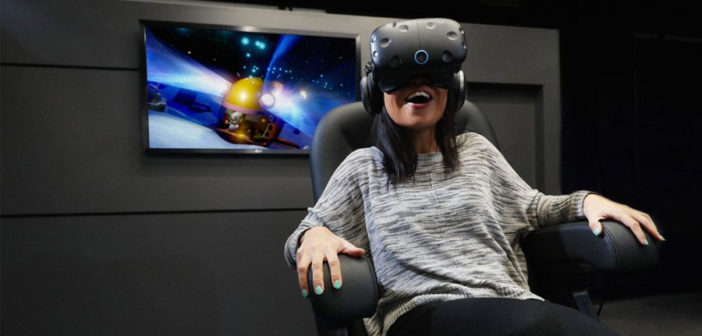Exorbitant costs, confused customers, and fire risks: bringing VR to the people is proving tricky.
But how will people experience it? The technology itself is too expensive for the vast majority of people, with full consumer models running upwards of $600–a lot of money to commit if you’ve never tried something–and cheaper versions on mobile offering little more than 360-degree video, which can be viewed without a headset.

“You go to a film festival, you get ticket in advance, you know when to line up,” says the media scholar and tech expert Tim Wu, the author of The Attention Merchants who’s part of Sundance Film Festival’s advisory group. “A reasonable number of people get to experience the films. We don’t have this figured out in VR.”At the virtual reality conference Versions earlier this year, Wu described the chaos of attending the VR gallery at Sundance Film Festival, where there are usually only a few headsets for each experience, often resulting in long lines for VR films that typically range between 5 and 10 minutes. “Overcoming those frictions is key,” he says. “If I had the magic bullet for how you do it, I would tell you.”

Because while the content itself is important, the experience surrounding VR is vital in encouraging more people to try it. One part of that is just finding a place to put it. “Space is a huge issue. If you want to set up a Vive, you need a 12-by-12-foot square. Increasingly, space in New York is not necessarily available all the time,” says Alex Darby, head of operations and production at the New Museum’s art and technology incubator, New Inc.Darby puts on events like the Versions conference, which is dedicated to VR and has two days of talks and workshops. Ironically, the opportunity to actually see VR experiences is limited to the conference’s afterparty. Setting it up is incredibly difficult from a production standpoint, she says. “The gaming engines required require dedicated circuits. Not all venues can support this,” she says. “If you can’t guarantee me this required AMP or a dedicated circuit, it might actually set your building on fire.”
Darby’s job entails working with New Inc’s VR creators, but she finds that even though she has incredible access to content, VR is still difficult for her to see. “Even if you can solve all of these problems and set something up, there’s maybe one headset,” Darby says. “It’s been a huge problem at Sundance and Tribeca [Film Festivals], even at a smaller scale where there’s less specific demand.”
But with the market size projected to be worth $5.2 billion by 2018, many companies are looking for ways to give consumers their first taste of VR, while dodging the logistical issues that come with the medium. Whether that’s in a dedicated arcade, a bar, or your local multiplex, VR is likely coming to a venue near you soon.

BACK TO THE ARCADE
Arcades have all but disappeared from the commercial landscape today, but in the 1970s and 1980s, they were hugely popular. Video game makers like Atari made millions on games like Pong, Space Invaders, and Pac-Man before consoles became cheap enough for people to purchase them personally and play games at home. In 2017, some believe that the arcade model, where visitors go to a dedicated place specifically to play games, is VR’s best bet at making its way into popular culture–just like its media predecessors before it.
“TV itself was in salons and bars before it went to people’s houses,” media scholar Wu says. “It’s a natural step. Maybe the rush to try to get into everyone’s houses has been a little premature and the natural step is the arcade.”
There are some examples of VR arcades sprouting up in the U.S. But the business model is most prevalent in Asian countries like China and Japan, where the Taiwanese company HTC, which makes the Vive VR headset, is bringing VR to thousands of arcades by the end of the year. In Taipei, the company opened a giant arcade-cum-theme park called Viveland at the end of 2016 that’s meant to act as an example for what a great arcade could look like, and inspire third parties to open their own.
Part of the problem is that anyone who wants to start an arcade has to independently negotiate licenses for content with each developer. For instance, if someone wanted to get a license to screen the VR film Life of Us, which has made the rounds on the festival circuit this year, they’d have to go directly to the film’s production company to buy the rights–and then do the same thing for every other experience they wanted to provide.So the company is launching a platform where HTC does that negotiation on arcade owners’ behalfs, and they can purchase a license for hundreds of hours of content directly through HTC.
“Anybody with a Vive essentially can start an arcade,” says Drew Bamford, a designer and the head of HTC Creative Labs. “We’re trying to make it as accessible as possible.” On the more immersive, high-end side of the spectrum, he images arcades that feature robust object tracking, haptic chairs, and even omnidirectional treadmills that would let you run freely in VR–something between an arcade and a theme park.
“In a lot of ways, it’s the Apple showroom,” says Jamin Warren, the founder of video game publication and company Kill Screen.
But that’s in Asia, where arcade culture is generally already accepted. It may not necessarily translate over to an American audience. “In some cases, those cultures have been in the lead in influencing the west so it’ll be interesting to see whether that’s the way it works this time,” Bamford says. “On the flip side, in general there’s a trend toward people wanting their own personal technology, driven partly by things like smartphones. You wouldn’t consider sharing that with somebody else.”

KARAOKE, WITH ZOMBIES
If dedicated arcades may come up against some cultural resistance, why not put virtual reality inside an establishment that’s already inside every neighborhood–the bar?
That’s what VR guru Michael Deathless thinks. His company, Deathless VR, which develops content, runs workshops, and even does VR art therapy classes, has experimented with putting virtual reality inside bars over the last year or so. He now puts on VR showcases at the restaurant The V Spot in Manhattan’s trendy East Village neighborhood on weekend nights, where you can eat vegan food (of course), grab a drink, and paint in Tiltbrush, all in the same venue.
“You go in, you drink a beer, eat a burrito, shoot some zombies,” he says. “It’s kind of like a karaoke situation.”
Deathless also opened a more permanent location–called Jump Into the Light–in September of 2016, where he offers four types of VR experiences from 5 p.m. until early in the morning, mostly targeting partiers who’d stumble upon the arcade after a night of drinking. Jump into the Light recently moved into another location, next to the lobby of the Indigo Hotel in the heart of one of New York’s hippest places to go out.
Deathless is a die-hard believer in VR’s future–and he means the name of his establishment quite literally. “We love screens. We love the light. We put thousands of people into their first experiences–the vast majority of people are blown away by it,” he says. “I don’t see it just as technology evolution, it’s the future of humanity.”
But the next step of combining VR with 21+ entertainment will have to wait for now. “I wish weed was legal,” Deathless says. “We want to pair weed with VR experiences. That’s the next level.”

HEADING TO THE GOOD OLD MULTIPLEX
While Deathless’s vision of VR is decidedly for adults (though he says he also hosts kids’ birthday parties all the time), other companies are looking to truly take it to the mainstream. Most prominently is Imax, the large-format film company that has chosen VR as the next product in the evolution of its business. And it’s putting it in a place that makes the most sense for a company primarily in the movie business: the multiplex.
Over Memorial Day weekend, Imax opened a VR arcade in the lobby of a New York City AMC theater. It’s the second of 10 pilot VR arcades that the company is rolling out over the course of 2017, starting with a standalone VR center in Los Angeles, and with multiplex arcades coming to theaters in Manchester in the U.K., Shanghai, Tokyo, Toronto, and more. Imax has also created a $50 million fund to invest in content developers, showing just how much it’s betting on VR’s future.
“The model that we like is similar to the model we like in cinema,” says Rob Lister, the chief development officer at Imax. “We partner with the exhibitor, provide them with Imax technology, we install it, and split the box office.”
Because Imax has relationships with movie theaters in 74 different countries, it could quickly scale up from 10 theaters to hundreds or even thousands, depending on how the pilot process goes.
To avoid the problem of lines, all Imax VR experiences are ticketed. Each VR center is composed of modular pods that are either 11-foot or 12-foot squares that are partially enclosed, designed to allow for a more social experience because they’ve found that most people who buy tickets are attending with two or more friends. The flexibility of the design, created by the architecture firm Gensler, allows the company to adjust the number and configuration of pods to fit into any space. In New York’s AMC, it takes up 2,900 square feet of the multiplex’s lobby, while another one the company is building is in retrofitted auditorium.
Lister says the company is testing everything from the cost (usually a dollar a minute), to the length of experiences (most range from eight to 12 minutes), to the amount of interactivity (so far, the more interactive the better), to the demographics. He says that while they expected their main demographic to be what he called “fanboys”–men in their late teens and early 20s who love Marvel movies–instead the attendees at the Los Angeles center has been less than 60% male. In March, they hosted a birthday party for a 35-year-old man on the same day as an 11-year-old girl. Currently, that center is pulling in between $13,000 to $15,000 per week, or about $700,000 per year. “That’s a very health business model,” Lister says.
It’d be a boon for movie theaters, too–the prospect of VR has the potential to bring millennials and generation Z back to the multiplex. A Nielsen report in 2014 shows that young people are seeing 15% fewer movies, while 87% of surveyed 12-to-24-year-olds were streaming movies online. But Imax is hoping to make VR more of a social experience, giving groups of young people more of a reason to try out the next kind of entertainment. Rolling out VR in movie theaters would also give people a place with which they are already familiar to experience the new medium for the first time.
Will the barriers to experiencing VR finally come down when it’s accessible in an arcade, a bar, or a movie theater? Developers still need to design content that’s so good, people will willingly pay $10 for a 10-minute game. But the first step is making the user experience around VR good enough to convince someone to put on a headset in the first place.
–
This article first appeared in www.fastcodesign.com
Seeking to build and grow your brand using the force of consumer insight, strategic foresight, creative disruption and technology prowess? Talk to us at +9714 3867728 or mail: info@groupisd.com or visit www.groupisd.com


![Imax VR Centre [Image: courtesy Imax]](https://assets.fastcompany.com/image/upload/w_707)


